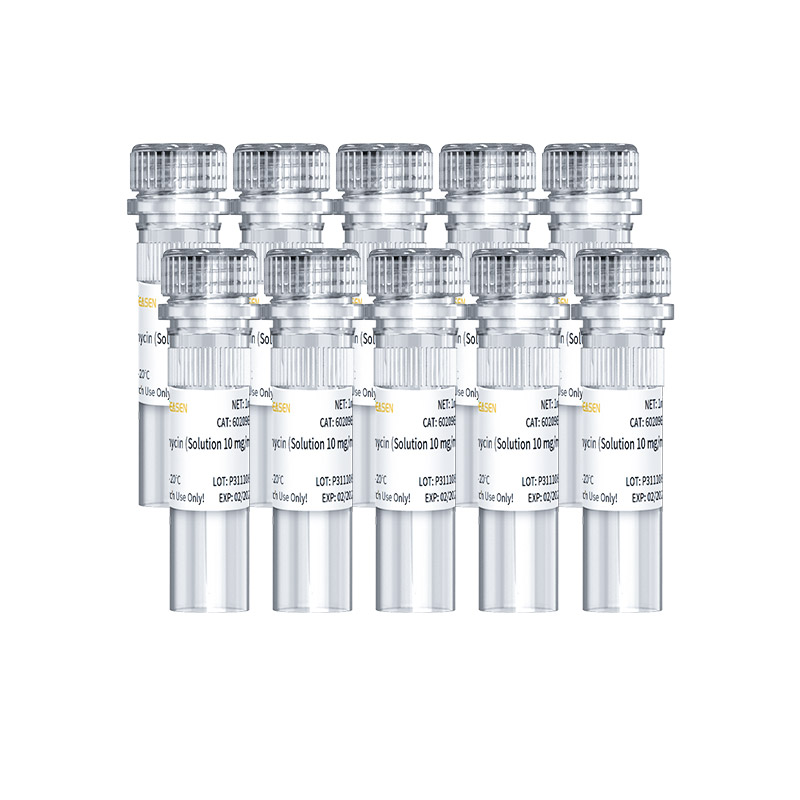
YEASEN은 생명과학 연구 및 진단을 위한 고품질의 연구용 시약과 기기를 제공하는 글로벌 바이오 기업입니다.

제품 설명
Puromycin (Solution 10 mg/mL)
제품 번호
60209ES10 - 1x1 mL
60209ES50 - 5x1 mL
60209ES60 - 10x1 mL
60209ES76 - 50x1 mL
제품 설명
Puromycin is an aminoglycoside antibiotic produced by fermentation and metabolism of Streptomyces alboniger, which kills Gram-positive bacteria, various animal and insect cells by inhibiting protein synthesis. Puromycin is effective against E. coli in some cases. The mechanism is that purinomycin is an analogue of the 3´terminal of aminoyl-TrNA molecules, which can bind to the A site of the ribosome and be incorporated into the extended peptide chain. After puromycin binds to the A site, it will not participate in any subsequent reactions, resulting in premature termination of protein synthesis and release of immature polypeptides containing puromycin at the C-terminus. Puromycin at a concentration of 1-10 µg/mL can successfully screen resistant wall mammalian cells, while puromycin at a low concentration of 0.5-2 µg/mL can successfully screen suspension cells.
This product is a stock solution of puromycin hydrochloride solution dissolved in distilled water, with a concentration of 10 mg/mL (10 mg/mL in H2O), and can be directly diluted with culture medium or other buffer solutions. Suitable for cell culture, common working concentration is 1-10 µg/mL.
Cat.No. | 60209ES10/60209ES50/60209ES60/60209ES76 |
Size | 1×1 mL/5×1 mL/10×1 mL/50×1 mL |
CAS NO. | 58-58-2 |
Molecular Fomular | C22H29N7O5·2HCl |
Molecular Weight | 544.43 g/mol |
Purity | ≥98% |
Structure |
|
Name | 60209ES10 | 60209ES50 | 60209ES60 | 60209ES76 |
Size | 1×1 mL | 5×1 mL | 10×1 mL | 50×1 mL |
The product should be stored at -25~-15℃ for one years.
1.Suggested working concentration
Mammalian cells: 1-10 μg/mL, optimum concentration needs to be determined by killing curve.
Escherichia coli: LB agar medium was used to screen Escherichia coli stably transformed with pac gene at a concentration of 125 μg/mL.
Note:Screening of stable E. coli strains using puromycin requires precise pH adjustment.
Recommended concentrations of purinomycin hydrochloride
cell line | Concentration (Purinomycin) | References |
B16 | 1-2 μg/mL | [1],[2] |
HEK293 | 0.5-10 μg/mL | [3] |
HeLa | 1-10 μg/mL | [4],[5] |
MEF | 1-5 μg/mL | [4] |
HepG2 | 0.5-5 μg/mL | [6],[7] |
A549 | 1.5 μg/mL | [8] |
human embryonic stem cell (HESCS) | 0.5-5 μg/mL | [9] |
2.Determination of purinomycin killing curve (taking shRNA transfection or lentivirus transduction as an example)
The effective screening concentration of purinomycin is related to cell type, growth state, cell density, cell metabolism and cell cycle position. To screen for stably expressing shRNA cell lines, it is critical to determine the minimum concentration of puromycin that kills untransfected/transduced cells. It is recommended that customers who are doing experiments for the first time must establish a kill curve suitable for their own experimental system.
1) Day 1: The 24-well plate is plated at a density of 5-8×104 cells/well, and a sufficient number of wells are plated for subsequent gradient experiments. Cells were incubated overnight at 37℃.
2) Day 2: A) Prepare screening medium: fresh medium containing different concentrations of puromycin (such as 0-15 μg/mL, at least 5 gradients); B) Replace the freshly prepared screening medium in the cells after overnight incubation; Then the cells are incubated at 37℃.
3) Day 4: Replace with fresh selection medium and observe cell viability.
4) Depending on the growth state of the cells, change to fresh selection medium every 2-3 days.
5) Cells were monitored daily to observe the rate of viable cells to determine the lowest concentration of drug effective to kill non-transfected or all non-transduced cells within 4-6 days of the start of antibiotic screening.
3. Screening of Mammalian Stably Transfected Cell Lines
After transfection of the plasmid containing the pac gene, the cells were propagated in a medium containing puromycin to select stable transfectants.
1) 48 h after transfection, the cells (original or diluted) are cultured in fresh medium containing an appropriate concentration of puromycin.
Note:Antibiotics are most effective when cells are actively dividing. If the cells are too dense, the effectiveness of antibiotics will be significantly reduced. It is best to plate cells to a density of no more than 25%.
2) Remove and replace the culture medium containing purinomycin every 2-3 days.
3) Cell-formed foci are assessed 7 days after screening. Lesions may require an additional week or more, depending on the host cell line and transfection screening efficiency.
Note:Observe the cell growth status every day. Screening of puromycin requires at least 48 h, and the screening period of effective concentration of puromycin is generally 3-10 days.
4)Transfer and place 5-10 resistant clones into a 35 mm Petri dish and continue to culture with selection medium for 7 days. This enrichment culture is to prepare for future cytotoxicity experiment
1.Purinomycin is a toxic compound, please handle with care.
2. For your safety and health, please wear lab coats and disposable gloves for operation.
3. For research use only.
Citations & References:
[1] Furge KA. et al., 2001. Suppression of Ras-mediated tumorigenicity and metastasis through inhibition of the Met receptor tyrosine kinase. PNAS 98:10722-7.
[2] Díaz J. et al., 2014.Rab5 is required in metastatic cancer cells for Caveolin-1-enhanced Rac1 activation, migration and invasion.. J Cell Sci. 127:2401-6.
[3] Rössger K. et al., 2013. Reward-based hypertension control by a synthetic brain-dopamine interface. PNAS, 110:18150-5.
[4] Kamer I. et al., 2005. Proapoptotic BID Is an ATM effector in the DNA-damage response Cell. 122:593-603.
[5] Charnaux N. et al., 2005. RANTES (CCL5) induces a CCR5-dependent accelerated shedding of syndecan-1 (CD138) and syndecan-4 from HeLa cells and forms.
[6] Gao J, Zhao N, Knutson M D, et al. The Hereditary Hemochromatosis Protein, HFE, Inhibits Iron Uptake via Down-regulation of Zip14 in HepG2 Cells[J]. Journal of Biological Chemistry, 2008, 283(31):21462-8.
[7] Huang J, Dibble C C, Matsuzaki M, et al. The TSC1-TSC2 complex is required for proper activation of mTOR2[J]. Molecular and Cellular Biology, 2008, 28(12):4104-4115.
[8] Nasser M W, Datta J, Nuovo G, et al. Nasser MW, Datta J, Nuovo G, Kutay H, Motiwala T, Majumder S, Wang B, Suster S, Jacob ST, Ghoshal KDown-regulation of micro-RNA-1 (miR-1) in lung cancer. Suppression of tumorigenic property of lung cancer cells and their sensitization to doxorubicin-induced apoptosis by miR-1. J Biol Chem 283: 33394-33405[J]. Journal of Biological Chemistry, 2008, 283(48):33394-33405.
[9] Paatero A O, Hilkka T, Happonen L J, et al. Bacteriophage Mu integration in yeast and mammalian genomes[J]. Nucleic Acids Research, 2008, 36(22): e148-e148.
YEASEN의 모든 제품을 만나 보세요!
YEASEN - Official Distributor in South Korea "Morebio" 한국 공식 대리점 "모아바이오"